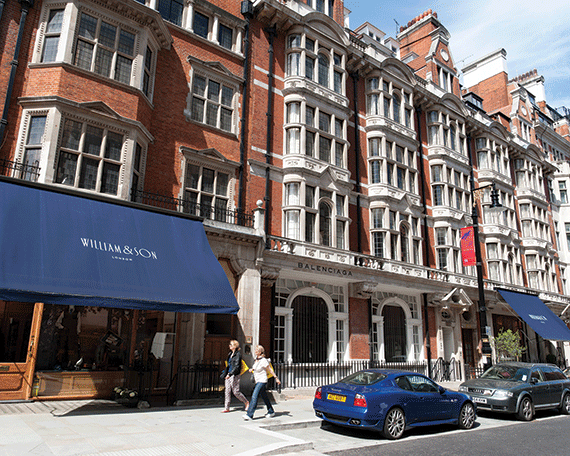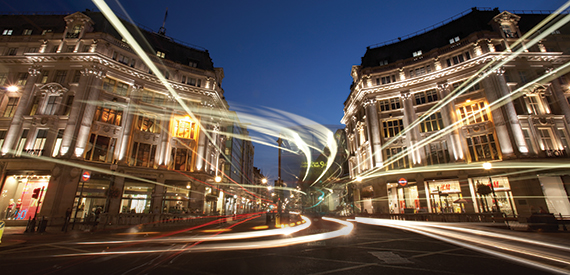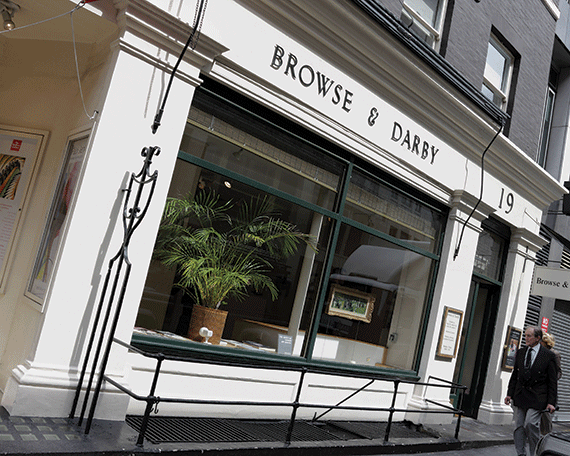 Choosing a piece of art is a personal matter. For some it is an instinctive decision, a connection, love at first sight. For others it takes time, deliberation, negotiation. Either way it is just as difficult to consider a purchase carefully as it is to fall instantly for a piece to the deafening sound of drills and construction machinery.
Choosing a piece of art is a personal matter. For some it is an instinctive decision, a connection, love at first sight. For others it takes time, deliberation, negotiation. Either way it is just as difficult to consider a purchase carefully as it is to fall instantly for a piece to the deafening sound of drills and construction machinery.
But this is fast becoming an all-too familiar scenario for many of the galleries in Mayfair, W1 – at least for those able to afford to stay in the area, as the buildings on the streets around them are targeted for luxury residential schemes. This includes Native Land’s £225m Burlington Gate redevelopment, which will include 42 flats and 25,000 sq ft of shops.
And the changing landscape in and around what was once the heart of the high-end London art scene is having a major knock-on effect.
Cork Street, W1, and its surrounds in Mayfair have been London’s gallery mecca since the 1870s. At its peak, there were 25 galleries on the street. Today there are seven. And as prices for space in the area soar to up to £575 per sq ft according to Savills, the remaining galleries are predominantly larger, international ones from competing art markets such as New York.
But could a simple, pop-up solution save the day? In March, South Kensington Estates announced it was planning to redevelop 1-5 Cromwell Place, SW7, into a new 35,000 sq ft gallery scheme. It would support independent artists and would, crucially, be affordable and flexible, with rents hovering nearer to £70 per sq ft.
Would a possible exodus from W1 to new, dedicated hubs be the making of the capital’s struggling art scene? And will buyers and investors follow suit or be put off by a formal departure from the well-heeled streets of Mayfair?
The price of art
Setting up a gallery in Mayfair is expensive. A small gallery of 1,000 sq ft costs £200,000 to renovate, followed by rent of around £500 per sq ft pa, according to Savills. In terms of uplift over the past five years, the firm reports that prime zone-A rents on Dover and Albemarle Streets have risen by 130% from £250 in 2011 to £575 per sq ft today. During the same period eight international galleries have opened in London, seven of which are in Mayfair’s luxury quarter.
And therein lies the problem. While the larger overseas – and some established, homegrown – galleries can afford the rents despite the uplift, the younger ones can’t. As they represent the future of London’s art scene, this could damage the city’s art culture that has been built up over hundreds of years.
Everything became clustered in Mayfair because it is where all the art auction houses are based, including Phillips, Sotheby’s and Christie’s.
“The serious international art world is centred around Mayfair,” says David Rosen of Pilcher Hershman, a property agent that specialises in the gallery market.
“They have to be in the same place for it to work. Some have moved out to other areas such as Peckham, but it does not yet have enough momentum,” he says.
It has not helped that it is not just the serious art scene that is gravitating towards Mayfair anymore. Fashion houses also want the kudos of a W1 address and in lieu of a much-sought-after Bond Street location, Mayfair is next on the list.
“Mayfair has become an iconic centre of fashion and affluence,” says John Martin, owner of John Martin Gallery on Albemarle Street. “The fashion houses started to look at Dover Street and Mount Street where there were a lot of galleries, and they colonised them for their boutiques. There was so much demand that suddenly rents trebled, and then, as a gallery, you have to make a decision. You can either pay it if you can afford it, but if you spend most of the year at art fairs, then what’s the point? Why pay the rent?”
Martin has had his gallery for 23 years. He recently moved upstairs because a designer shoe shop took the ground-floor unit.
Competition from international galleries has also forced rents up. High-powered American art houses such as Gagosian, Pace, Hauser & Wirth, Michael Werner and David Zwirner have opened or expanded in the area within the past five years.
They usually look to take large spaces of 10,000-20,000 sq ft, and are happy to pay top dollar for the rent, effectively locking out small aspiring businesses.
A controversial question to pose could be, does this actually matter? While it may not have always been so expensive, Mayfair has long been known as the location of London’s high-end art scene. So how important is the influx of fresh blood and young, home-grown talent?
“Young emerging galleries and established galleries need to be in the cluster to create a dynamic art market,” says Martin. “If you close the doors to the emerging galleries then it has a damaging long-term effect on the art market and the area. The international galleries can pay the high rents, but the most interesting ones normally can’t, so we need to start thinking of new strategies.”
Hub of creativity
So, could the Cromwell Place scheme in South Kensington be the first step towards a solution? The planned space, which could be up and running by 2018, will offer a flexible and more affordable option for galleries in London, where they can rent gallery and office space on a short-term basis.
The five buildings will be converted to provide curators and art institutions with office space, exhibition space, viewing rooms and storage space.
There will be 16 exhibition spaces, ranging from 400-3,000 sq ft. Corylos, the company set up by John Martin and Scott Murdoch, which will run from Cromwell Place, is taking the overriding lease for 25 years, paying a rent similar to offices, which in SW7 is roughly £85 per sq ft.
The exhibition and office space will then be let to businesses on flexible, short-term leases, similar to a pop-up model. The galleries will pay a combination of annual membership fees and rents, which will vary depending on the size of the space and the time of year. Prices will start from £1,000 for two weeks.
“This means that smaller galleries can have a foothold in the centre of London, and it would cut their costs by 40%, which is huge,” says Martin.
Tim Butler, managing director of South Kensington Estates, which owns the properties, says: “Having a healthy mix of businesses in an area is important. We could maximise our income in the short term by just working with the big companies, but ultimately it is important to take a long-term view of the area. If we are just grabbing the highest rent that we can get every time, then ultimately the area will become devalued.”
While this model is the first of its kind in London, there are similar schemes planned in Hong Kong and San Francisco, where the property and art world have been working together to try to keep artists and galleries in the city centre.
But will it work?
Now that Mayfair has become a stomping ground for high-end galleries and international art houses, London must evolve to welcome art in other areas of town. This has started happening in Shoreditch, E1, but it works only if investors and buyers follow.
“Whether Cromwell Place will work I don’t know, but I am optimistic that it could work in the same way the east has worked for other galleries,” says Pilcher Hershman’s Rosen. “South Kensington is not the traditional location for high-end art, but it might appeal to start ups and people considering fringe locations.”
Rocketing rents
And could the provision of such an innovative space be the start of a more overarching focus on galleries and studio spaces in mixed-use developments to counteract the effect of rocketing Mayfair rents? Rosen says there is growing understanding in the property industry of the importance of the arts.
He says: “More developers understand the benefits of having a gallery. What would be nice would be to see more developers having mixed-use schemes with dedicated spaces that appeal to the art world.”
Westminster Council has also shown support. It recently organised a round table discussion with the minister of culture and landlords from Mayfair to come up with ideas to protect the galleries.
One suggestion was to introduce a separate use classification, separating them from retail. A similar change of use was enforced on Savile Row, W1, which means that only tailors can take space on the street now.
Once the dust and the drilling settles on Cork Street, hopefully the remaining galleries will still be there. And if not, maybe the property industry’s focus on new hubs and spaces for art and artists at the heart of mixed-use schemes could save the day.

View from the artist
It is not just the art dealers that are being pushed out of the city. Artists are struggling to stay in London too.
Studio spaces across the capital have been closing their doors. Why? Because they are being bought by developers, often to be turned into luxury flats.
The Cremer Street studio in Hackney, E8, had to close earlier this year for that reason, leaving London with 90 fewer studio spaces and 120 artists with nowhere to work.
In 2014, the Greater London Authority estimated that over the next five years, 3,500 artists are likely to lose their studios in London.
Zanny Mellor, a young artist in London, has had to move studios three times last year.
“It is not ideal,” she says. “You never have a definite lease. It is tricky for artists as most spaces are not owned, and so everyone has to move out further and further.”
Many artists opt to pack up and leave for a better quality of life elsewhere. Berlin is seen as an affordable option, as the city invests in maintaining prices for studio rent.
“A lot of people have been saying that we are in danger of losing a lot of artists and creative practitioners because of the pricing,” she says.
Mellor uses ASB Studio Company, which finds space in properties that are going to be developed, for her studio. It enables artists to rent space affordably until the development happens.
Another firm, Acne, works in collaboration with housing developers to provide studio space on the ground floor of blocks of flats, but competition with retail and office occupiers makes this challenging.
The rental model has got more expensive too. “Artists have left because it is hard with the rent that you pay. It is a reduced rent on housing, but I have had to have a number of different income streams in order to make money for the studio space,” she says.
Mellor is currently renting space from an art school in Waterloo, SE1, but it is rare to find affordable space in zone 1.
She says that hardly anyone can afford space in Shoreditch, E1, any more, and it has been so tough for her in the past that she has considered leaving London altogether.
“The last couple of months have been a struggle, and you need to think about whether you can find a better quality of life somewhere else.”
View from the gallery owner
Charles Bradstock owns Browse & Darby, one of the seven galleries left on Cork Street. He has had the space since 1976 and has recently had to hire an independent adjudicator as his landlord wants to more than double his £70,000 pa rent.
“Initially they said it would go to £180,000, but I think they are asking for £150,000 now, which is still quite a jump,” he says.
“The likes of Victoria Beckham are paying these crazy sums on Dover Street. It doesn’t help us when people are paying these astronomical rents,” he adds.
But he will not move if he can avoid it, and says that having a gallery in Mayfair is imperative to his business.
“More of the gallery existence is going online, but if you have American clients, they feel much safer if they know you have a building in the street that isn’t going to suddenly disappear.”
Bradstock’s gallery is in the middle of residential projects, and Cork Street looks more like a building site than somewhere to spend the day buying art. Although the developers have said that they will incorporate gallery space into the ground and lower ground floors of their scheme, Bradstock still is concerned.
“There is nothing written in concrete, so they could just whack fashion houses in if they wanted to. A lot of these houses can afford to run loss leaders, so they will pay whatever,” he says.
To send feedback, e-mail amber.rolt@estatesgazette.com or tweet @amberrolt or @estatesgazette












